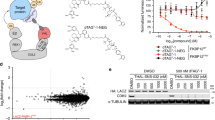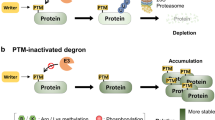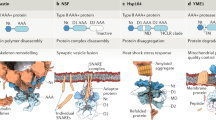Abstract
Regulated changes in protein conformation can have profound effects on protein function, although routine laboratory methods often fail to detect them. The recently discovered BAG-family proteins may operate as bridging molecules that recruit molecular chaperones to target proteins, presumably modulating protein functions through alterations in their conformations, and ultimately affecting diverse cellular behaviours including cell division, migration, differentiation and death. Emerging knowledge about BAG-family proteins indicates that there may be a mechanism for influencing signal transduction through non-covalent post-translational modifications.
This is a preview of subscription content, access via your institution
Access options
Subscribe to this journal
Receive 12 print issues and online access
$209.00 per year
only $17.42 per issue
Buy this article
- Purchase on Springer Link
- Instant access to full article PDF
Prices may be subject to local taxes which are calculated during checkout



Similar content being viewed by others
References
Takayama, S., Xie, Z. & Reed, J. An evolutionarily conserved family of Hsp70/Hsc70 molecular chaperone regulators. J. Biol. Chem. 274, 781–786 (1999).
Takayama, S., Bimston, D. N., Matsuzawa, S., Freeman, B. C., Aime-Sempe, C., Xie, Z. et al. BAG-1 modulates the chaperone activity of Hsp70/Hsc70. EMBO J. 16, 4887–4896 (1997).
Zeiner, M., Gebauer, M. & Gehring, U. Mammalian protein RAP46: an interaction partner and modulator of 70 kDa heat shock proteins. EMBO J. 16, 5483–5490 (1997).
Luders, J., Demand, J. & Hohfeld, J. The ubiquitin-related bag-1 provides a link between the molecular chaperones hsc70/hsp70 and the proteasome. J. Biol. Chem. 275, 4613–4617 (2000).
Takayama, S., Krajewski, S., Krajewski, M., Kitada, S., Zapata, J. M., Kochel, K. et al. Expression and location of Hsp70/Hsc-binding anti-apoptotic protein BAG-1 and its variants in normal tissues and tumor cell lines. Cancer Res. 58, 3116–3131 (1998).
Schneikert, J., Hubner, S., Martin, E. & Cato, A. C. A nuclear action of the eukaryotic cochaperone RAP46 in downregulation of glucocorticoid receptor activity. J. Cell. Biol. 146, 929–940 (1999).
Lu, P. J., Zhou, X. Z., Shen, M. & Lu, K. P. Function of WW domains as phosphoserine- or phosphothreonine-binding modules. Science 283, 1325–1328 (1999).
Frydman, J. Folding of newly translated proteins in vivo: The role of molecular chaperones. Ann. Rev. Biochem. 70, 603–647 (2001).
Cheung, J. & Smith, D. F. Molecular chaperone interactions with steroid receptors: an update. Mol. Endocrinol. 14, 939–946 (2000).
Beere, H. M. & Green, D. R. Stress management - heat shock protein-70 and the regulation of apoptosis. Trends Cell Biol. 11, 6–10 (2001).
Takayama, S., Sato, T., Krajewski, S., Kochecl, K., Irie, S., Millan, J. A. et al. Cloning and functional analysis of BAG-1: a novel Bcl-2 binding protein with anti-cell death activity. Cell 80, 279–284 (1995).
Wang, H.-G., Takayama, S., Rapp, U. R. & Reed, J. C. Bcl-2 interacting protein, BAG-1, binds to and activates the kinase Raf-1. Proc. Natl. Acad. Sci. USA 93, 7063–7068 (1996).
Song, J., Takeda, M. & Morimoto, R. I. Bag1-Hsp70 mediates a physiological stress signalling pathway that regulates Raf-21/ERK and cell growth. Nature Cell Biol. 3, 276–282 (2001).
Matsuzawa, S., Takayama, S., Froesch, B. A., Zapata, J. M. & Reed, J. C. p53-inducible human homologue of Drosophila seven in absentia (Siah) inhibits cell growth: suppression by BAG-1. EMBO J. 17, 2736–2747 (1998).
Matsuzawa, S. & Reed, J. C. Siah-1, SIP, and Ebi collaborate in a novel pathway for ?-catenin degradation linked to p53 responses. Mol. Cell 7, 915–926 (2001).
Clevenger, C. V., Thickman, K., Ngo, W., Chang, W.-P., Takayama, S. & Reed, J. C. Role of Bag-1 in the survival and proliferation of the cytokine-dependent lymphocyte lines, Ba/F3 and Nb2. Mol. Endocrinol. 11, 608–618 (1997).
Bardelli, A., Longati, P., Albero, D., Goruppi, S., Schneider, C., Ponzetto, C. et al. HGF receptor associates with the anti-apoptotic protein BAG-1 and prevents cell death. EMBO J. 15, 6205–6212 (1996).
Packham, G., Brimmell, M. & Cleveland, J. L. Mammalian cells express two differently localized Bag-1 isoforms generated by alternative translation initiation. Biochem. J. 328, 807–813 (1997).
Yang, X., Chernenko, G., Hao, Y., Ding, Z., Peter, M. M., Pater, A. et al. Human BAG-1 / RAP46 protein is generated as four isoforms by alternative translation initiation and overexpressed in cancer cells. Oncogene 17, 981–989 (1998).
Zeiner, M., Niyaz, Y. & Gehring, U. The hsp70-associating protein Hap46 binds to DNA and stimulates transcription. Proc. Natl. Acad. Sci. USA 96, 10194–10199 (1999).
Niyaz, Y., Zeiner, M. & Gehring, U. Transcriptional activation by the human Hsp70-associating protein Hap50. J. Cell Sci. 114, 1839–1845 (2001).
Zeiner, M. & Gehring, U. A protein that interacts with members of the nuclear hormone receptor family: identification and cDNA cloning. Proc. Natl. Acad. Sci. USA 92, 11465–11469 (1995).
Froesch, B. A., Takayama, S. & Reed, J. C. BAG-1L protein enhances androgen receptor function. J. Biol. Chem. 273, 11660–11666 (1998).
Knee, D. A., Froesch, B. A., Nuber, U., Takayama, S. & Reed, J. C. Structure-function analysis of Bag1 proteins: effects on androgen receptor transcriptional activity. J. Biol. Chem. 276, 12718–12724 (2001).
Guzey, M., Takayama, S. & Reed, J. C. BAG1L enhances trans-activation function of the vitamin D receptor. J. Biol. Chem. 275, 40749–40756 (2000).
Kullmann, M., Schneikert, J., Moll, J., Heck, S., Zeiner, M., Gehring, U. et al. RAP46 is a negative regulator of glucocorticoid receptor action and hormone induced apoptosis. J. Biol. Chem. 273, 14620–14625 (1998).
Liu, R., Takayama, S., Zheng, Y., Froesch, B., Chen, G. -Q., Zhang, X. et al. Interaction of BAG-1 with retinoic acid receptor and its inhibition of retinoic acid-induced apoptosis in cancer cells. J. Biol. Chem. 273, 16985–16992 (1998).
Brimmell, M., Burns, J. S., Munson, P., McDonald, L., O'Hare, M. J., Lakhani, S. R. et al. High level expression of differentially localized BAG-1 isoforms in some oestrogen receptor-positive human breast cancers. Brit. J. Cancer 81, 1042–1051 (1999).
Turner, B. C., Krajewski, S., Krajewski, M., Takayama, S., Gumbs, A. A., Rebbeck, T. R. et al. BAG-1: A novel biomarker predicting long term survival in early-stage breast cancer. J. Clin. Oncol. 19, 992–1000 (2001).
Tang, S.-C., Shaheta, N., Chernenko, G., Khalifa, M. & Wang, X. Expression of BAG-1 in invasive breast carcinomas. J. Clin. Oncol. 17, 1710–1719 (1999).
Yamauchi, H., Adachi, M., Sakata, K. -I., Hareyama, M., Satoh, M., Himi, T. et al. Nuclear BAG-1 localization and the risk of recurrence after radiation therapy in laryngeal carcinoma. Cancer Lett. 165, 103–110 (2001).
Doong, H., Price, J., Kim, Y. S., Gasbarre, C., Probst, J., Liotta, L. A. et al. CAIR-1/BAG-3 forms an EGF-regulated ternary complex with phospholipase C-? and hsp70/hsc70. Oncogene 19, 4385–4395 (2000).
Lee, J. H., Takahashi, T., Yasuhara, N., Inazawa, J., Kamada, S. & Tsujimoto, Y. Bis, a bcl-2 binding protein that synergizes with bcl-2 in preventing cell death. Oncogene 18, 6183–6190 (1999).
Jiang, Y., Woronicz, J. D., Liu, W. & Goeddel, D. V. Prevention of constitutive TNF receptor 1 signaling by silencer of death domains. Science 283, 543–546 (1999).
Tschopp, J., Martinon, F. & Hofmann, K. Apoptosis: Silencing the death receptors. Curr. Biol. 9, R381–R384 (1999).
Ozawa, F., Friess, H., Zimmermann, A., Kleeff, J. & Büchler, M. W. Enhanced expression of Silencer of Death Domains (SODD/BAG-4) in pancreatic cancer. Biochem. Biophys. Res. Commun. 271, 409–413 (2000).
Thress, K., Henzel, W., Shillinglaw, W. & Kornbluth, S. Scythe: A novel reaper-binding apoptotic regulator. EMBO J. 17, 6135–6143 (1998).
Thress, K., Song, J., Morimoto, R. I. & Kornbluth, S. Reversible inhibition of Hsp70 chaperone function by Scythe and Reaper. EMBO J. 20, 1033–1041. (2001).
Höhfeld, J. & Jentsch, S. GrpE-like regulation of the Hsc70 chaperone by the anti-apoptotic protein BAG-1. EMBO J. 16, 6209–6216 (1997).
Bimston, D., Song, J., Winchester, D., Takayama, S., Reed, J. C. & Morimoto, R. I. Bag-1, a negative regulator of HSP70 chaperone activity, uncouples nucleotide hydrolysis from substrate release. EMBO J. 17, 6871–6878 (1998).
Terada, K. & Mori, M. Human DnaJ homologs dj2 and dj3, and bag-1 are positive cochaperones of hsc70. J. Biol. Chem. 275, 24728–24734 (2000).
Gässler, C. S., Wiederkehr, T., Brehmer, D., Bukau, B. & Mayer, M. P. Bag-1M accelerates nucleotide release for human Hsc70 and Hsp70 and can act concentration dependent as positive and negative cofactor. J. Biol. Chem. (in the press).
Stuart, J. K., Myszka, D. G., Joss, L., Mitchell, R. S., McDonald, S. M., Takayama, S. et al. Characterization of interactions between the anti-apoptotic protein BAG-1 and Hsc70 molecular chaperones. J. Biol. Chem. 273, 22506–22514 (1998).
Brehmer, D., Rudiger, S., Gassler, C. S., Klostermeier, D., Packschies, L., Reinstein, J. et al. Tuning of chaperone activity of Hsp70 proteins by modulation of nucleotide exchange. Nature Struct. Biol. 8, 427–432 (2001).
Frydman, J. & Hohfeld, J. Chaperones get in touch: the hip-hop connection. Trends Biochem. Sci. 22, 87–92 (1997).
McClellan, A. J. & Frydman, J. Molecular chaperones and the art of recognizing a lost cause. Nature Cell Biol. 3, E1–3 (2001).
Harrison, C. J., Hayer-Hartl, M., Di Liberto, M., Hartl, F. -U. & Kuriyan, J. Crystal structure of the nucleotide exchange factor GrpE bound to the ATPase domain of the molecular chaperone DnaK. Science 276, 431–435 (1997).
Sondermann, H., Scheufler, C., Schneider, C., Hohfeld, J., Hartl, F. U. & Moarefi, I. Structure of a Bag/Hsc70 complex: convergent functional evolution of Hsp70 nucleotide exchange factors. Science 291, 1553–1557 (2001).
Briknarova, K., Takayama, S., Brive, L., Harvert, M. L., Knee, D. A., Velasco, J. et al. Structural analysis of BAG1 cochaperone and its interactions with Hsc70 heat shock protein. Nature Struct. Biol. 8, 349–352 (2001).
Buchberger, A., Schroder, H., Buttner, M., Valencia, A. & Bukau, B. A conserved loop in the ATPase domain of the DnaK chaperone is essential for stable binding of GrpE. Nature Struct. Biol. 1, 95–101 (1994).
Misura, K. M., Scheller, R. H. & Weis, W. I. Three-dimensional structure of the neuronal-Sec1-syntaxin 1a complex. Nature 404, 355–362 (2000).
Fernandez, I., Ubach, J., Dulubova, I., Zhang, X., Sudhof, T. C. & Rizo, J. Three-dimensional structure of an evolutionarily conserved N-terminal domain of syntaxin 1A. Cell 94, 841–849 (1998).
Sattler, M., Liang, H., Nettesheim, D., Meadows, R. P., Harlan, J. E., Eberstadt, M. et al. Structure of Bcl-xL–Bak peptide complex: recognition between regulators of apoptosis. Science 275, 983–986 (1997).
Acknowledgements
We thank the National Cancer Institute and the Department of Defense for their generous support.
Author information
Authors and Affiliations
Rights and permissions
About this article
Cite this article
Takayama, S., Reed, J. Molecular chaperone targeting and regulation by BAG family proteins. Nat Cell Biol 3, E237–E241 (2001). https://doi.org/10.1038/ncb1001-e237
Issue Date:
DOI: https://doi.org/10.1038/ncb1001-e237
This article is cited by
-
Distal hereditary motor neuronopathy as a new phenotype associated with variants in BAG3
Journal of Neurology (2024)
-
Molecular Chaperones as Therapeutic Target: Hallmark of Neurodegenerative Disorders
Molecular Neurobiology (2023)
-
Evolution of Bcl-2 Anthogenes (BAG) as the Regulators of Cell Death in Wild and Cultivated Oryza Species
Journal of Plant Growth Regulation (2023)
-
Putting human Tid-1 in context: an insight into its role in the cell and in different disease states
Cell Communication and Signaling (2022)
-
Global identification of phospho-dependent SCF substrates reveals a FBXO22 phosphodegron and an ERK-FBXO22-BAG3 axis in tumorigenesis
Cell Death & Differentiation (2022)



